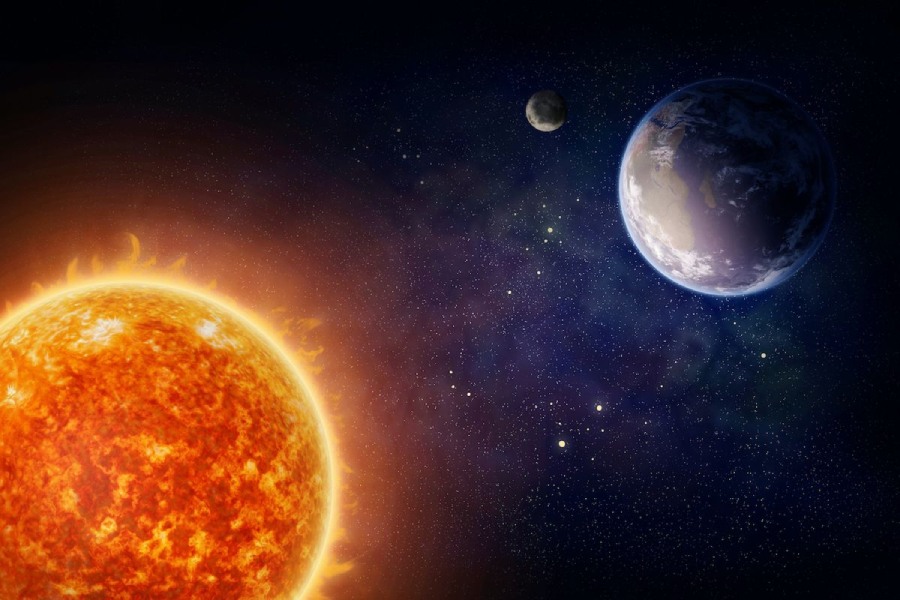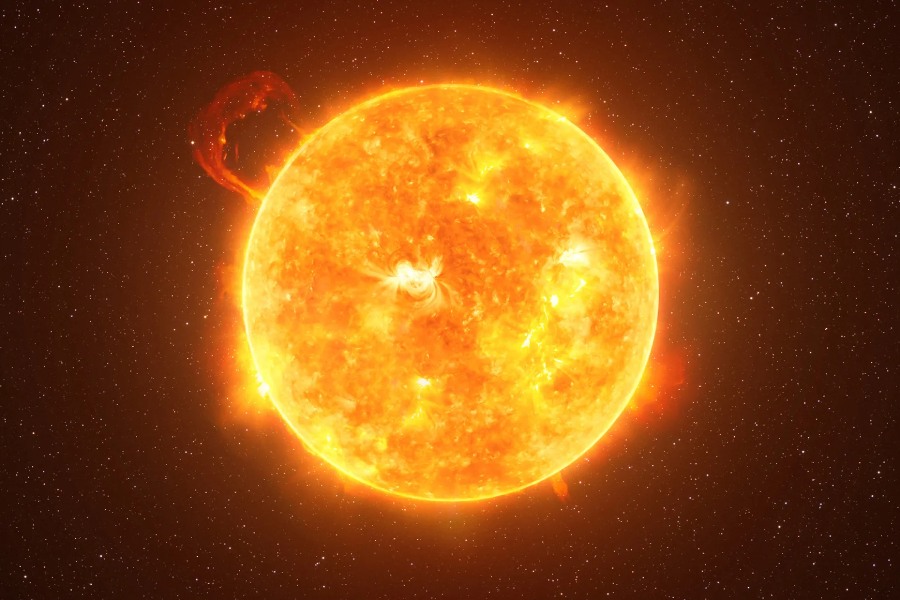The burning ball of gas, our Sun, looks small when viewed from the Earth. But this illusion of size is caused by the massive distance between the Sun and the Earth. So, how big is the Sun in reality? How big is the Sun compared to the moon?
In this article, we’ll explore the Sun’s diameter, volume, and mass to gauge its true size. Understanding how many Earths could fit inside if the Sun were hollow provides an intuitive grasp of the Sun’s enormity. One might be surprised by the sheer size of our closest star as they calculate and visualize the scale comparisons.
Join us on a mathematical journey to comprehend the Sun’s surprisingly vast proportions relative to familiar frames of reference here on our tiny Earth.

How Big Is the Sun?
The Sun is enormous, like a colossal ball of fiery gas. Its diameter spans about 1,391,400 km (864,600 mi), making it incredibly vast. To put it in perspective, you could line up approximately 109 Earth side by side across its width.
Its immense size is what allows it to emit such intense light and heat. This sustains life on Earth and fuels the processes that shape our Solar System.
Diameter of the Sun
The diameter of the Sun refers to the length measuring straight across the Sun’s equator. Knowing the Sun’s equatorial diameter allows us to comprehend its vast size compared to other objects, like Earth. It also lets astronomers calculate properties like volume and density.
How is the Sun’s diameter measured?
Early astronomers viewed the Sun through telescopes and placed circular masks over the lenses. This allowed estimates of the fraction blocked by the Sun’s disk. However, heat from sunlight caused errors in 19th-century measurements.
Today, more accurate angular size measurements are used. Modern techniques measure the Sun’s angular diameter – the angle it subtends as viewed from Earth – rather than its true diameter. Astronomers then employ geometry and Earth’s known orbit radius to deduce the size.
Space probes and planet transits now corroborate these angular diameter findings: calculations confirm that the Sun spans about 1.39 million km (approximately 864,159.63 miles). Its sheer scale underscores the Sun’s ongoing impact on Earth and its critical role in our Solar System.
Volume of the Sun
The volume of the Sun refers to the amount of space taken up by all its matter. Knowing the volume lets scientists calculate the Sun’s density and mass. These help scientists understand forces within the Sun and its effects on our Solar System.
How do scientists calculate the Sun’s volume?
The volume of a sphere is calculated using the formula 4/3 πr3. Scientists determine the Sun’s diameter by dividing this number to find its radius (r). They then apply this value to the sphere formula to find its volume.
The Sun’s sky angle is determined by its size and distance. Astronomers use angular data in conjunction with the distance between the Sun and Earth. This combination provides another estimate of the Sun’s true diameter and, consequently, its volume.
Currently, the accepted volume of the Sun is 1.4 x 1027 cubic meters. This is 1,300,000 times larger than the volume of Earth. Such an immense size highlights the Sun’s crucial and dominant role as the anchor of our Solar System.
Surface area of the Sun
The Sun’s surface area refers to the total space taken up by its outermost layer. It relates to the emission of solar energy and particles. Knowing the surface area lets scientists calculate the Sun’s temperature and density.
How do scientists measure the Sun’s surface area?
The formula to find the surface area of a sphere is 4πr2. Scientists divide the Sun’s measured diameter number by two to get its radius. This radius value is squared and multiplied to determine the total surface area.
The Sun’s angular width depends on its true width and distance. Combining sky angle measurements with distance figures gives another diameter and surface area estimate.
Today’s accepted value for solar surface area is 6.1×1018 square meters – over 10,000 times Earth’s total area. This underscores the domain of the Sun’s far-reaching energies bathing Earth and our solar neighborhood.

Angular size and apparent magnitude
The apparent size of an object is measured in units like milliarcseconds. The Sun’s angular size is determined by its actual width and distance from the observer. This measurement employs a reverse numeric scale visible to an observer.
The Sun’s intense brightness results in an apparent magnitude of around -27. Combining this with its distance allows for the determination of its true width. Monitoring changes in its size over time offers valuable insights into solar dynamics. These variations also assist in the calibration of scientific instruments.
Why quantify apparent brightness?
Understanding solar activity cycles is aided by monitoring energy output fluctuations tied to the solar cycle, which can either dim or boost the apparent magnitude. Detailed brightness monitoring is essential for enhancing solar science.
Devices such as diffraction gratings and heliometers make use of optics and geometry. Additionally, space telescopes accurately monitor our closest star. By combining ground-based and orbital data, they contribute to improving solar models used in forecasting space weather.
Calculating the Sun’s volume and mass
Determining the volume and mass of the Sun involves meticulous observations and sophisticated theoretical models. Spectroscopic analysis of its light provides insights into its chemical composition, temperature, and density.
Scientists estimate the Sun’s luminosity and radius using the solar constant, Earth-Sun distance, and Stefan-Boltzmann law. Complex models of stellar interiors, incorporating principles like hydrostatic equilibrium and nuclear fusion, help unravel its structure and properties. Helioseismology, studying solar oscillations, further illuminates the Sun’s interior dynamics.
Gravitational effects, governed by Newton’s law, enable the calculation of the Sun’s mass from its gravitational pull on other celestial bodies. Integrating these methodologies, scientists estimate the Sun’s volume at approximately 1.41 x 10^18 cubic kilometers and its mass at about 1.989 x 10^30 kilograms.
These figures underscore the Sun’s colossal scale, dominating the Solar System with over 99% of its mass and serving as the fundamental engine driving its dynamics. Understanding the Sun’s magnitude showcases its celestial prominence and enriches our comprehension of stellar phenomena and astrophysical processes.
Sun vs. Jupiter: A Tale of Two Titans
How big is the Sun compared to Jupiter? While the Sun may not be the biggest star in the galaxy, it dwarfs our own Solar System’s giant, Jupiter. Even though Jupiter is the largest planet in our Solar System, the Sun is about 10 times wider than Jupiter.
Imagine Jupiter as a giant beach ball; the Sun, in comparison, would be a massive hot air balloon. This vast size difference allows the Sun’s gravity to grasp our entire Solar System.
How Big Is the Sun Compared to Other Stars?
Our middle-of-the-road star
What is bigger than the Sun? The answer is quite a lot! Our Sun is an average-sized star. It’s dwarfed by much larger supergiants while also outshining smaller red dwarfs.
Scientists utilize the Hertzsprung-Russell diagram for classifying stars according to their brightness and temperature. Within this diagram, our Sun is positioned in the main sequence section. This location reveals insights into the Sun’s size relative to other stars. It sits squarely in the middle, not the largest nor the smallest.
Our ordinary yet life-sustaining star
Formed approximately 4.6 billion years ago, the Sun currently resides in its stable prime, where it steadily fuses hydrogen in its core. With a mass about 330,000 times that of Earth, it aligns with the average mass for a yellow main sequence star and consists mainly of hydrogen and helium.
Maintaining a consistent brightness and minimal temperature fluctuations, the Sun provides Earth with a reliably warm environment. Its substantial mass plays a crucial role in stabilizing planetary orbits over billions of years, a fundamental aspect of the sustenance of life.
While the allure of giant stars may capture attention, ordinary main-sequence stars like our Sun are likely the most prevalent hosts for habitable worlds. In this regard, our Sun may epitomize numerous other stars dispersed throughout the Milky Way Galaxy, each harboring the potential to foster life.
Conclusion
How big is the Sun? The Sun is so enormous that it makes Earth and the other planets orbiting it seem tiny in comparison. Its diameter is large enough to engulf over a million Earth-sized globes, and its volume could fit 1.3 million Earth-sized planets.
Understanding the immense size of the Sun can expand one’s cosmic awareness. Despite its familiarity with Earth’s skies, the Sun is significantly larger than our planet. Observing the Sun may now evoke awe for its life-sustaining light and its unimaginable size.
